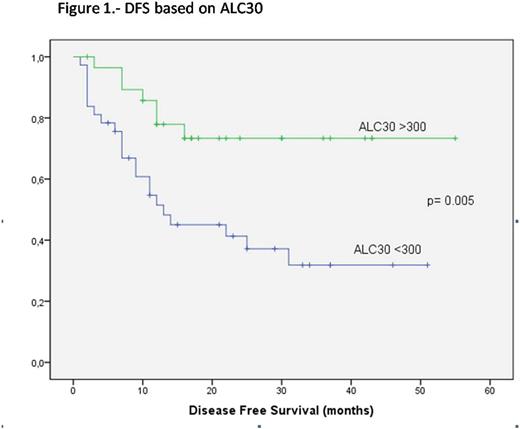Abstract
Introduction:
Early immune reconstitution (EIR) is clinically relevant for the outcome of allogeneic hematopoietic stem cell transplantation. In the setting of unmanipulated haploidentical transplantation (Haplo-HSCT), some groups have identified the absolute leukocyte count on day +30 (ALC30) as an independent prognostic factor in terms of overall survival (OS), disease free survival (DFS) and infectious mortality (IM).
The aim of this study was to evaluate the impact of EIR on OS, DFS and IM among patients who underwent Haplo-HSCT with postransplant cyclophosphamide (PTCy) at our institution.
Patients and methods:
Sixty-six patients received a Haplo-HSCT at our institution from July 2011 to February 2016. Conditioning regimen consisted of fludarabine, cyclophosphamide and busulfan. Forty-five percent of the patients received a myeloablative regimen, including busulfan for 3 or 4 days, while 55% were conditioned using a reduced intensity regimen with 1 or 2 days of busulfan. Graft-versus-host disease (GVHD) prophylaxis was based on PTCy, cyclosporine and mycophenolate mofetil.
EIR was assessed by means of ALC30 (cellular analyzer DXH, Beckman Coulter®), CD3+ lymphocyte count on day +30 (CD3-30) and NK-lymphocyte count on day +30 (NK30), both determined by multiparametric flow cytometry (FC500 and Navios, Beckman Coulter®).
The Kaplan-Meier method was used to evaluate OS rate and DFS rate. Differences in survival rate were assessed using the log-rank test. P values <0.05 were considered statistically significant.
Results:
We analyzed 66 patients, with a median follow-up of 17 months (8-31). The median age of the patients was 43 years (range 30-57), 77% were men. The diagnosis were: acute myeloid leukemia 33%, acute lymphoid leukemia 8%, chronic myeloid leukemia 6%, Hodgkin lymphoma 21%, non-Hodgkin lymphoma 17%, myelodysplastic syndrome 8%, myelofibrosis (MF) 4%, others 3%. Most patients were in complete remission at the time of the transplant (56%), while 21% were in partial remission and 23% with overt disease.
CMV reactivation was documented in 74% of the patients, 8% developed a proven invasive fungal infection and 36% suffered from hemorrhagic cystitis. Median OS and DFS were 17 (8-31) and 13 months (7-26), respectively. IM rate was 27% at the end of follow up.
ROC curves were used to determine the optimal cut-off values for each of the studied variables: 300 cells/µL for ALC30, 120 cells/µL for CD3-30 and 40 cells/µL for NK30 were chosen.
Those patients with an ALC30 ≥ 300/µL had longer OS (p=0.001) and DFS (p=0.005). Median OS and DFS were 25 months vs. not reached (NR) and 13 months vs. NR respectively.
Patients with CD3-30 ≥120/µL had better OS (p=0.07, non-significant) and similar DFS than those with CD3-30 <120/µL. No differences were observed for the NK30 in terms of OS and DFS. Cumulative incidence of IM was significantly lower in patients with an ALC30≥300 (p=0.001). Cumulative incidence of relapse was not affected by ALC30. Patients with CD3-30>120/µL had a lower incidence of relapse than patients with CD3-30<120/µL (p=0.06, non-significant).
Conclusions:
Our study supports the independent prognostic significance of early immune reconstitution after unmanipulated haploidentical transplantation with postransplant cyclophosphamide, previously described by other groups. Patients with an ALC30 count over 300 cells/µL have a statistically significant better overall survival, disease free survival and a lower cumulative incidence of infectious mortality. However, ALC30 seems to have no correlation with relapse rate. CD3+ and NK-cell total counts on day 30 seem to have less prognostic impact, according to our study.
No relevant conflicts of interest to declare.
Author notes
Asterisk with author names denotes non-ASH members.




This feature is available to Subscribers Only
Sign In or Create an Account Close Modal